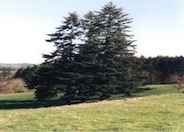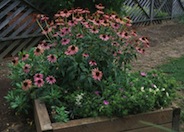
Common name:Douglas Fir
Botanical name:Pseudotsuga menziesii
On older trees of this variety, the bark is thick, corky, and deeply fissured. The crown changes from a conical form and becomes broad and flat-crowned with age, making the branches wide and drooping. Its cones are 3"-4" long, and have 3 pointed bracts that extend beyond the needles of the scales. The buds are cigar-shaped, and the bark of the young trees is smooth and gray. This is a highly combustible plant.

Common name:Purple Coneflower
Botanical name:Echinacea purpurea
The Purple Coneflower is a long-lived, reliable standby for the perennial garden. Rosy purple petals fall below the prominent orange-tinged cone and blooms in late June to September. It should be placed toward the front or middle of the border, or interplanted with Ox-Eye Daisy in the cut flower garden. It should be grown in fertile, well-drained soil. The plant blooms well in shade, but does even better in sun. -Holland WIldflower Farm
| Designer: | Formal Decorative Fence |
Photographer: Duane Morris |
Soils and Compost:
Physical weed control, including mulching, or hand removal protects the watershed from harmful chemicals.
Water Saving Tip:
Be sure to fix all leaks promptly no matter how small they may seem.
Integrated Pest Management:
Attract, or buy beneficial insects such as ladybugs and lacewings to control pest outbreaks in your garden.

